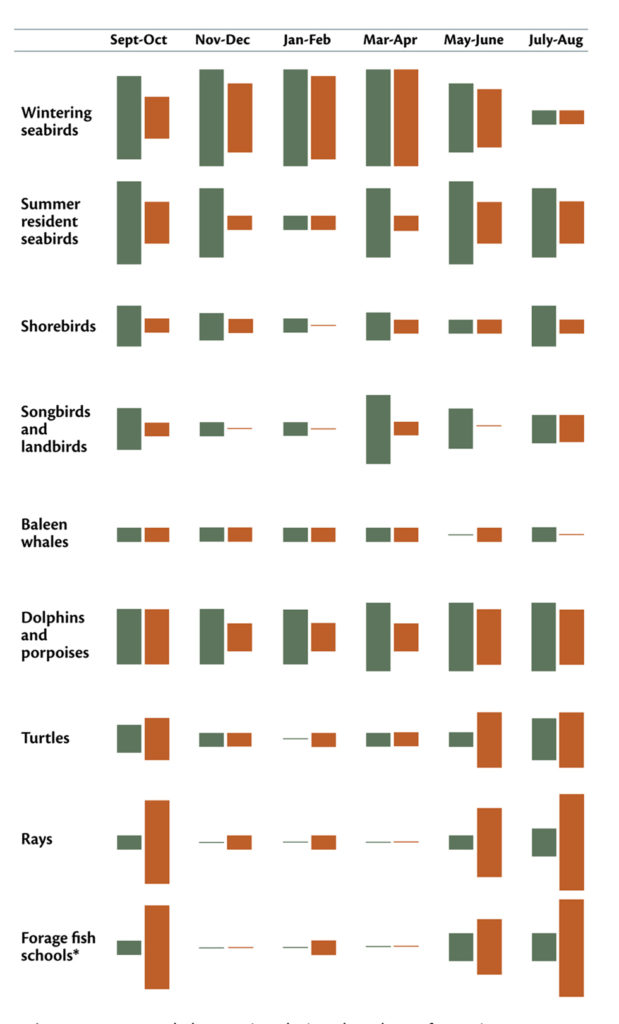The mid-Atlantic region provides important habitat for marine wildlife over the course of the year. Each season brings a unique shift in habitat characteristics and with it a new array of species reliant on the specific resources available. Despite seasonal variation, however, some nearshore areas showed persistent patterns of high species richness and abundance year-round
Persistent Geographic Patterns


These areas were likely attractive to a wide variety of animals due to consistently high primary productivity relative to the broader study area. This primary productivity forms the base of the pelagic food chain on which nearly all species observed during this study rely; thus, areas near the mouths of the bays likely provided important and reliable foraging habitat for a multitude of species year-round. Areas offshore of Maryland, where high-density surveys were conducted in state waters, also had high diversity and relative abundance. Areas near the mouths of the bays likely provided important and reliable foraging habitat for a multitude of species year-round.
These maps highlight areas where the greatest number of species (left) and the greatest number of individuals across all taxa (right) were consistently observed over the course of the study. For more details on persistent hotspots maps, see the Analysis page.
>
Seasonal Patterns
Fall: Seabird species composition shifted as summer residents, such as terns, shearwaters, and storm-petrels, migrated south. Winter residents, such as scoters, Northern Gannets, and Red-throated Loons, migrated into the study area from breeding grounds. Seabirds were more associated with nearshore habitats in the fall compared to winter and spring. Songbirds, shorebirds, Eastern Red Bats, and Peregrine Falcons migrated through the open waters of the study area. Cownose Rays were seen in dense migratory aggregations. Schools of forage fish were seen along the coast. Sea turtles and Bottlenose Dolphins remained through late fall, while Common Dolphins arrived in November.
Winter: Wintering seabirds occupied habitat throughout the study area, although distribution patterns varied among species. Northern Gannets were broadly distributed across the study area, while scoters (Surf Scoters, White-winged Scoters, and Black Scoters) were concentrated in nearshore regions by the bays. Small numbers of alcids (Atlantic Puffins, Razorbills, Dovekies, and murres) were observed throughout the area. Baleen whales were most commonly observed during this season. Dolphin species composition shifted from Bottlenose Dolphins to Common Dolphins, which were most abundant in the winter.
Spring: High species diversity was observed in the spring.Wintering seabirds departed the study area, while summer resident seabirds arrived from breeding or overwintering areas. Bottlenose Dolphins and sea turtles also began using the study area. Songbirds, shorebirds, and raptors migrated over open waters across the region.
Summer: Breeding seabirds, such as Common Terns, were observed foraging near the shore and the mouths of the bays, while nonbreeding species, such as Wilson’s Storm-Petrels, were broadly distributed across the study area. In general, seabirds were more associated with nearshore areas in the summer. Large numbers of Cownose Rays migrated through the study area. Sea turtles and Bottlenose Dolphins were most abundant during the summer.

Temporal changes in relative abundance for major taxonomic groups. Data are from the boat-based surveys (green, left) and high resolution digital video aerial surveys (brown, right) conducted in 2012-2014. Species included in each category are listed in Williams et al. (2015). Labels refer to seasons in the Northern Hemisphere. *Forage fish were counted as schools, not as individuals, unlike the other animal groups.
Conclusions
This study provides unique baseline data on distributions, movements, habitat use, and relative abundance of wildlife on the mid-Atlantic Outer Continental Shelf. The various methods used in this study provide the most comprehensive view to date of marine wildlife in this region. These approaches led to several key conclusions:
- Habitat gradients in nearshore waters were important influences on productivity and patterns of species distributions and abundance. Areas offshore of the mouths of Chesapeake and Delaware Bays, as well as to the south of Delaware Bay along the coast, were consistent hotspots of abundance and species diversity, regardless of survey methodology or analytical approach.
- The study area was important for wintering and breeding taxa, and its location also made it a key migratory corridor. There was considerable variation in species composition and spatial patterns by season, largely driven by dynamic environmental conditions.
References
- Santora, JA, Veit RR (2013) Spatio-temporal persistence of top predator hotspots near the Antarctic Peninsula. Marine Ecology Progress Series 487:278-304. do:10.3354/meps10350


